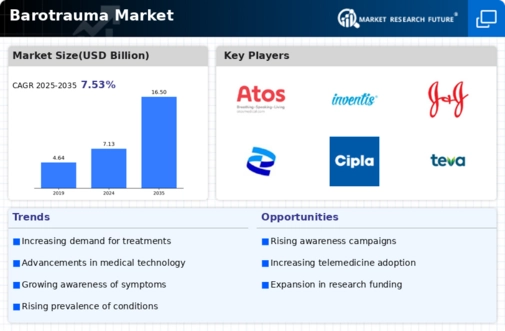Market Share
Barotrauma Market Share Analysis
The competitive market of Barotrauma market makes the companies in it to use various mechanisms to ensure the market share which they have or to increase that they have. In the area of differentiation, these firms stand out, as they are majorly occupied in the development of new specific drugs and medical devices that serve the conditions associated with barotrauma. This can include the invention of new fun drugs, meds or unique remedies which are not only different from traditional ones with respect to benefits and results but also give them a separate position advantage and set them apart from the other treatments being done.
Cost leadership remains to be one of the important strategies in the Barotrauma Market sphere necessitating companies to be viewed as the lowest cost providers. Doing that means optimizing production processes (including the negotiation of better price deals with suppliers) and designing the distribution systems in a way that better reduces the level of overall costs. Through offering competitive pricing firms could draw a wider range of customers' coverage, even more so in the case of healthcare that is often used for economical hospital allocation.
The market segments determine the location for standing up within the Barotrauma Market. Companies are nowadays classifying decompression illness in different subclasses or serving population groups with only limited needs. Personalizing treatments and gadgets to servicing specific needs of these groups ensure efficiency, compared to using generic products. In the end, adoption by clinicians and consumers becomes higher.
Partnerships and associations play a very big role in occupying the Barotrauma Market as a leading brand name. Often partnerships between companies are established with universities, health institutions or businesses from other industries to create pool of resources and exchange of knowledge for faster innovation. Through such collaborations, companies will be able to remain at the advanced end of the technology spectrum and even gain an upper hand in the context of barotrauma-related health care solutions as they are applied.
Market and promotional activities are invaluable if one wishes to occupy a certain position in the market for Barotrauma products. Businesses provide funds for educational examples to teach people how to avoid pressure injuries of the ear, their reasons, and possible treatment options. We implement targeted advertising, Medical conferences participation, and communication with medical practitioners which determines the trust of people and also the recognition of the enterprise which generally raises the visibility of our brand.
Regulatory strategies are forward with the complexity of Barotrauma marketplace regulation and thus should be devised and put into practice. Medical device and treatment manufactures go on working hard for their products approval in the market and assure the safety and efficiency standards through regulating their products.
PM surveillance and after investigation give us the significant basis on in what areas to include in our market share positioning for Barotrauma Market. The active performance by companies of the manufacturing products safety and effectiveness tracking at market level through post-studying in the long-run carries the message of the companies' commitment to continuous improvement.


















Leave a Comment